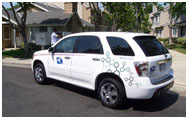U.S. Postal Service tests new hydrogen fuel cell vehicle
The world’s largest civilian fleet owner wants to drive the market for green transportation.
Rain, sleet and snow won't stop the nation's mail carriers, but rising gas prices could slow them down. The U.S. Postal Service estimates every 1-cent increase in the price of a gallon of gasoline drives up annual fleet operating costs by $8 million. In 2007, the fuel bill was $1.7 billion; this year it's expected to grow another $600 million.
Not surprising, the agency that operates vehicles in every community in America was more than happy in July to accept a Chevrolet Equinox fuel cell electric vehicle from General Motors. The company's latest version of a hydrogen vehicle requires no petroleum-based fuel.

In an agreement with General Motors, the Postal Service is participating in a two-year test of the fourth-generation electric vehicle in Irvine, Calif. With a fleet of 220,000 vehicles across the country, the Postal Service is in a good position to help drive the hydrogen market, if the vehicles eventually become commercially viable, said Richard Maher, a USPS spokesman in Irvine.
"It's not like any other vehicle," said Maher, who has driven it. "It's totally silent. The acceleration is very smooth and it builds up to a good speed pretty quickly, but you can't hear it."
The ultra-quiet vehicle is a little disquieting for most drivers initially, because they wonder if it's actually running, he said.
"The carriers like it a lot. It's very comfortable," Maher said. The Postal Service tested General Motors' previous prototype, which was smaller and even quieter than the current Equinox. That version wasn't as practical because space for mail was more limited and pedestrians would often be startled when the vehicle moved because they didn't realize it was running. The new version, while quiet inside, generates enough noise outside to reduce the startle factor for pedestrians, Maher said.
Roz Sell, commercial program manager for General Motors fuel cell commercialization office, says the Postal Service offers an ideal setting for testing. The agency is using the vehicle for regular mail delivery six days a week with lots of starts and stops. "That's an excellent duty cycle for us to understand," said Sell.
It also helps promote the hydrogen fuel cell concept to the public when they see the vehicle being operated safely and effectively. "They're out and about in the neighborhoods -- people see them in use," she said.
Every time the vehicle is refueled, the hydrogen pump collects data about the fuel cell and automatically sends it to General Motors engineers, who monitor the vehicle's performance remotely, Sell said.
General Motors is testing more than 100 fuel cell vehicles, most in the Los Angeles area, and a handful in New York and Washington. Besides the Postal Service, the Energy Department, Walt Disney Co., Virgin Atlantic and a handful of private citizens are testing hydrogen fuel cell vehicles for General Motors, Sell said.
The most limiting factor right now is the hydrogen fuel itself. There are only two pumps in the country that offer public access, one in Washington and one near Los Angeles. "It's been discouraging how slow energy companies have been bringing [hydrogen] online," she said.







